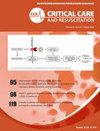Protocol for the development of NHMRC-endorsed guidelines for extracorporeal membrane oxygenation using GRADE methodology
IF 1.7
4区 医学
Q3 CRITICAL CARE MEDICINE
引用次数: 0
Abstract
Introduction
The last 15 years have seen a rapid expansion in the use of extracorporeal life support. ECMO has evolved from a rescue treatment available in a few expert centres to an organ support modality for many forms of severe respiratory or cardiovascular failure. There is currently wide variation around the indications for, management of, and systems to support the practice of ECMO. There are few available guidelines on this topic; most have limitations and are not readily generalisable to the Australian or New Zealand healthcare systems.
Methods and analysis
This article aims to describe the processes that will be used to produce evidence-based guidelines on the use of ECMO in Australia and New Zealand. The protocol is informed by the National Health and Medical Research Council (NHMRC) Guidelines for Guidelines, and the Grading of Recommendations, Assessment, Development and Evaluation (GRADE) framework.
Analysis of available evidence on the identified questions follows a three-phase approach. Firstly, published guidelines will be identified and an assessment of their relevance, methodology and validity carried out. If there are no guidelines on the topic, the second step involves a search and evaluation of systematic reviews. Lastly, a de-novo systematic analysis of primary literature will be undertaken where no systematic reviews are available. The development process will be conducted using the GRADEpro and Covidence software for de novo systematic reviews.
Dissemination
The guideline will be published in peer-reviewed journals and summaries will be provided to end-users via the GRADEpro GDT application.
制定使用GRADE方法的nhmrc认可的体外膜氧合指南的协议
在过去的15年里,体外生命支持的使用迅速扩大。ECMO已从少数专家中心提供的抢救治疗发展为多种形式的严重呼吸或心血管衰竭的器官支持方式。目前,围绕ECMO的适应症、管理和支持实践的系统存在很大差异。关于这个主题的指导方针很少;大多数都有局限性,并不容易推广到澳大利亚或新西兰的医疗保健系统。方法和分析本文旨在描述将用于在澳大利亚和新西兰制定ECMO使用循证指南的过程。该方案以国家卫生和医学研究委员会(NHMRC)指南指南以及建议、评估、发展和评价分级(GRADE)框架为依据。对已确定问题的现有证据的分析遵循三个阶段的方法。首先,将确定已公布的准则,并对其相关性、方法和有效性进行评估。如果没有关于该主题的指导方针,第二步涉及对系统评论的搜索和评估。最后,在没有系统综述的情况下,将对原始文献进行从头开始的系统分析。开发过程将使用GRADEpro和covid软件进行从头系统审查。该指南将发表在同行评审的期刊上,并将通过GRADEpro GDT应用程序向最终用户提供摘要。
本文章由计算机程序翻译,如有差异,请以英文原文为准。
求助全文
约1分钟内获得全文
求助全文
来源期刊

Critical Care and Resuscitation
CRITICAL CARE MEDICINE-
CiteScore
7.70
自引率
3.40%
发文量
44
审稿时长
>12 weeks
期刊介绍:
ritical Care and Resuscitation (CC&R) is the official scientific journal of the College of Intensive Care Medicine (CICM). The Journal is a quarterly publication (ISSN 1441-2772) with original articles of scientific and clinical interest in the specialities of Critical Care, Intensive Care, Anaesthesia, Emergency Medicine and related disciplines.
The Journal is received by all Fellows and trainees, along with an increasing number of subscribers from around the world.
The CC&R Journal currently has an impact factor of 3.3, placing it in 8th position in world critical care journals and in first position in the world outside the USA and Europe.
 求助内容:
求助内容: 应助结果提醒方式:
应助结果提醒方式:


